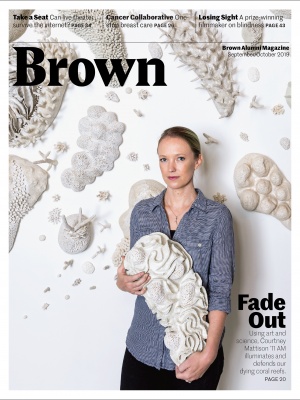W
hen I talk with our undergraduates, individually or in small groups, I often ask them why they chose to attend Brown. Almost uniformly, and perhaps predictably, the answer is “the Open Curriculum.” I usually follow this question by asking them to elaborate on what, exactly, makes the Open Curriculum so compelling.
You might expect students to respond by talking about the mechanics of the Open Curriculum—for example, that courses can be taken Satisfactory/No Credit (Brown’s version of Pass/Fail) and that there are no core distribution requirements. And, in truth, I do occasionally hear students express their appreciation for not being forced to take specific subjects that they prefer not to study.
But, more often, the discussion is quite different. Some students say that they love having the flexibility to dive deeply into more than one subject, for example pairing mathematics and music, or neuroscience and economics. Others appreciate the thought and intentionality they put into the selection of their courses during the “shopping period” at the beginning of each semester. And yet others describe the intellectual vibrancy of a community comprised of students who, together with faculty, are deeply engaged in their learning.
Now, as we celebrate the 50th anniversary of the Open Curriculum, it is a good time to reflect on the genesis and consequences of the curricular changes put into place a half-century ago.
May 7, 1969, was a pivotal day. Classes were cancelled and faculty gathered for a marathon meeting to discuss and vote on elements of the New Curriculum. Brown students convened at Faunce House to draft a statement of academic principles, passed by the faculty the following day.
These principles articulate a philosophy of education that has defined the Brown experience for fifty years.
“The purpose of education for the undergraduate at Brown University,” the statement read, “is to foster the intellectual and personal development of the individual student … [who] must be an active participant in framing their education.”
It went on to highlight the centrality of students’ “relationships with professors, fellow students, and the material they approach together”—a clear affirmation of the power of collaborative learning.
Of course, the statement reflected the times. The zeitgeist of 1969—roiling political and social upheaval centered on civil rights and the Vietnam War—also infused higher education. The status quo was questioned. Conventional wisdom was challenged.
The moment was right for curricular reform, for new ideas about how to put students at the center of the educational experience. Faculty at Brown were more open to hearing from students. Students wanted a voice in decisions that shaped how they would be educated. Over time, the process of shared governance unfolded. Building on the research and thought leadership of what was Brown’s first Group Independent Studies Project, the moment was right for the Open Curriculum.
All this permeates the culture today at Brown, where students, faculty, and staff continue to work together with collegiality and mutual respect.
Brown’s signature approach to free inquiry and collaboration is not just embodied in the curriculum. It is expressed through programs like the Meiklejohn Peer Advisors, the Writing Fellows, and the Undergraduate Teaching Assistants. All show how peer-to-peer learning—students teaching other students—is a powerful way to advance the education of both the students being taught and the students who provide the teaching or guidance.
To know the origin story of the Open Curriculum is to know Brown’s ethos. Brown doesn’t have an open curriculum because it believes 17-to-21-year-olds know exactly what they want. We have one because smart, motivated students demonstrated it is the best option for allowing them to learn how to learn and discover what they want to learn.
I have complete faith that, although the substance of what is taught at Brown will evolve, the principles underlying the Open Curriculum will continue to serve us well for at least the next 50 years.
This makes me tremendously optimistic about Brown’s future. Because the beating heart of the Open Curriculum, after all, is its optimism—its utter faith in students as seekers of knowledge who take responsibility for their intellectual and personal growth.





